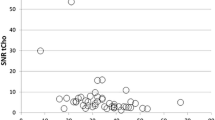Abstract
Magnetic resonance imaging (MRI) of the breast has emerged as a highly sensitive modality. In addition to morphologic and kinetic analysis obtained from contrast-enhanced breast MRI, functional information has been needed for diagnosis of breast disease. In vivo proton (hydrogen 1 [1H]) MR spectroscopy of the breast has demonstrated that choline (Cho) can be detected in breast cancers, whereas Cho is generally undetectable in normal breast tissue. Thus, breast MR spectroscopy has shown great promise as a way to differentiate between benign and malignant lesions and to gauge the effect of chemotherapeutic agents in patients with locally advanced breast cancer. Prior studies performed on 1.5-T MR imagers have reported sensitivities of 70–100% (average 89%; 149/168) and specificity of 67–100% (average 87%; 97/112) for breast MR spectroscopy. Moreover, the presence of a Cho peak in breast cancer may reflect the increased cell proliferation, with a decrease in this peak after treatment reflecting decreased viability of the tumor. With further development and the assessment of Cho quantity in the tumor, breast MR spectroscopy may be helpful in the elucidation of the biology of breast cancer.





Similar content being viewed by others
References
Orel SG, Schnall MD, Newman RW, Powell CM, Torosian MH, Rosato EF. MR imaging-guided localization and biopsy of breast lesions: initial experience. Radiology. 1994;193:97–102.
Roebuck JR, Cecil KM, Schnall MD, Lenkinski RE. Human breast lesions: characterization with proton MR spectroscopy. Radiology. 1998;209:269–75.
Gribbestad IS, Singstad TE, Nilsen G, Fjøsne HE, Engan T, Haugen OA, Rinck PA. In vivo 1H MRS of normal breast and breast tumors using a dedicated double breast coil. J Magn Reson Imaging. 1998;8:1191–7.
Kvistad KA, Bakken IJ, Gribbestad IS, Ehrnholm B, Lundgren S, Fjøsne HE, Haraldseth O. Characterization of neoplastic and normal human breast tissues with in vivo (1) H MR spectroscopy. J Magn Reson Imaging. 1999;10:159–64.
Cecil KM, Schnall MD, Siegelman ES, Lenkinski RE. The evaluation of human breast lesions with magnetic resonance imaging and proton magnetic resonance spectroscopy. Breast Cancer Res Treat. 2001;68:45–54.
Yeung DK, Cheung HS, Tse GM. Human breast lesions: characterization with contrast-enhanced in vivo proton MR spectroscopy—initial results. Radiology. 2001;220:40–6.
Jagannathan NR, Kumar M, Seenu V, Coshic O, Dwivedi SN, Julka PK, Srivastava A, Rath GK. Evaluation of total choline from in-vivo volume localized proton MR spectroscopy and its response to neoadjuvant chemotherapy in locally advanced breast cancer. Br J Cancer. 2001;84:1016–22.
Tse GM, Cheung HS, Pang LM, Chu WC, Law BK, Kung FY, Yeung DK. Characterization of lesions of the breast with proton MR spectroscopy: comparison of carcinomas, benign lesions, and phyllodes tumors. AJR Am J Roentgenol. 2003;181:1267–72.
Huang W, Fisher PR, Dulaimy K, Tudorica LA, O’Hea B, Button TM. Detection of breast malignancy: diagnostic MR protocol for improved specificity. Radiology. 2004;232:585–91.
Bartella L, Morris EA, Dershaw DD, Liberman L, Thakur SB, Moskowitz C, Guido J, Huang W. Proton MR spectroscopy with choline peak as malignancy marker improves positive predictive value for breast cancer diagnosis: preliminary study. Radiology. 2006;239:686–92.
Tozaki M, Fukuda K. Supine MR mammography using VIBE with parallel acquisition technique for the planning of breast-conserving surgery: clinical feasibility. The Breast. 2006;15:137–40.
Stanwell P, Mountford C. In vivo proton MR spectroscopy of the breast. Radiographics. 2007;27:S253–66.
Bolan PJ, DelaBarre L, Baker EH, Merkle H, Everson LI, Yee D, Garwood M. Eliminating spurious lipid sidebands in 1H MRS of breast lesions. Magn Reson Med. 2002;48:215–22.
Star-Lack J, Nelson SJ, Kurhanewicz J, Huang LR, Vigneron DB. Improved water and lipid suppression for 3D PRESS CSI using RF band selective inversion with gradient dephasing (BASING). Magn Reson Med. 1997;38:311–21.
Males RG, Vigneron DB, Star-Lack J, Falbo SC, Nelson SJ, Hricak H, Kurhanewicz J. Clinical application of BASING and spectral/spatial water and lipid suppression pulses for prostate cancer staging and localization by in vivo 3D 1H magnetic resonance spectroscopic imaging. Magn Reson Med. 2000;43:17–22.
Stanwell P, Gluch L, Clark D, Tomanek B, Baker L, Giuffrè B, Lean C, Malycha P, Mountford C. Specificity of choline metabolites for in vivo diagnosis of breast cancer using 1H MRS at 1.5 T. Eur Radiol. 2005;15:1037–43.
Bolan PJ, Meisamy S, Baker EH, Lin J, Emory T, Nelson M, Everson LI, Yee D, Garwood M. In vivo quantification of choline compounds in the breast with 1H MR spectroscopy. Magn Reson Med. 2003;50:1134–43.
Glunde K, Jie C, Bhujwalla ZM. Molecular causes of the aberrant choline phospholipid metabolism in breast cancer. Cancer Res. 2004;64:4270–6.
Tse GM, Yeung DK, King AD, Cheung HS, Yang WT. In vivo proton magnetic resonance spectroscopy of breast lesions: an update. Breast Cancer Res Treat. 2007;104:249–55.
Bartella L, Huang W. Proton (1H) MR spectroscopy of the breast. Radiographics. 2007;27:S241–52.
Meisamy S, Bolan PJ, Baker EH, Bliss RL, Gulbahce E, Everson LI, Nelson MT, Emory TH, Tuttle TM, Yee D, Garwood M. Neoadjuvant chemotherapy of locally advanced breast cancer: predicting response with in vivo (1) H MR spectroscopy—a pilot study at 4 T. Radiology. 2004;233:424–31.
Kumar M, Jagannathan NR, Seenu V, Dwivedi SN, Julka PK, Rath GK. Monitoring the therapeutic response of locally advanced breast cancer patients: sequential in vivo proton MR spectroscopy study. J Magn Reson Imaging. 2006;24:325–32.
Manton DJ, Chaturvedi A, Hubbard A, Lind MJ, Lowry M, Maraveyas A, Pickles MD, Tozer DJ, Turnbull LW. Neoadjuvant chemotherapy in breast cancer: early response prediction with quantitative MR imaging and spectroscopy. Br J Cancer. 2006;94:427–35.
Acknowledgments
The review study was supported by Katsuya Maruyama (Siemens-Asahi Medical Technologies LTD, Tokyo, Japan), and we greatly appreciate his help.
Author information
Authors and Affiliations
Corresponding author
About this article
Cite this article
Tozaki, M. Proton MR spectroscopy of the breast. Breast Cancer 15, 218–223 (2008). https://doi.org/10.1007/s12282-008-0048-x
Published:
Issue Date:
DOI: https://doi.org/10.1007/s12282-008-0048-x




